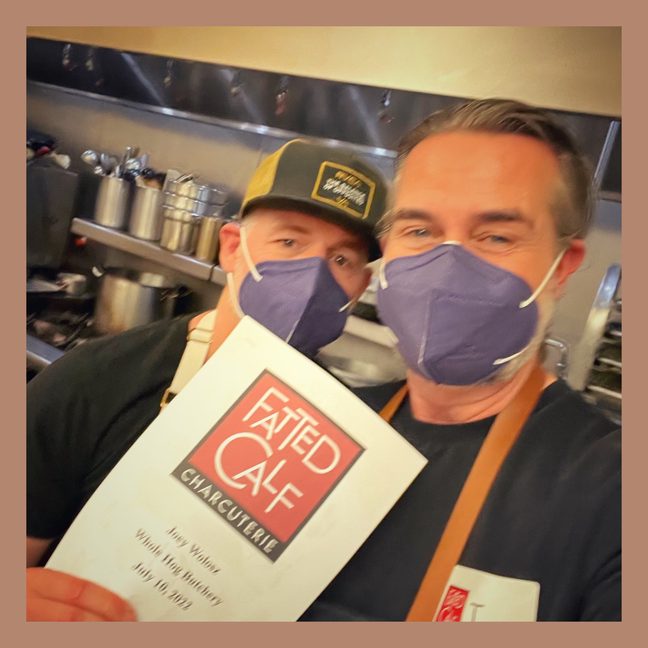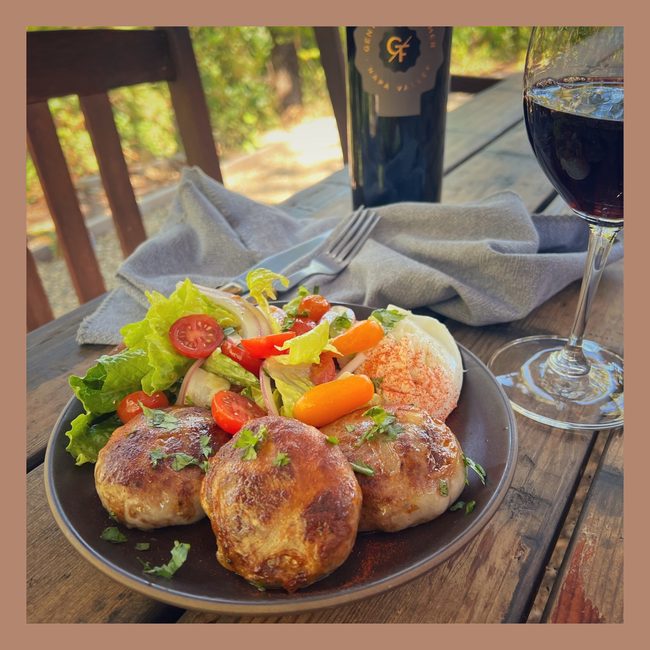July 2022: Issue 19
The Grill, The Trill, and The Chill Meat Thy Maker Tea Boned Gaze into Merguez
by Joey Wolosz | Published July 21, 2022
A Note from Joey Wolosz
We are in the thick heat of summer, aka outdoor grilling season. I have been lighting up the wood pit in our back garden, putting homemade sausages and other meaty treats literally to the fire.
In this missive, we visit the foundation of meaty treats: butchery. Jeff and I spent an afternoon with Taylor Boetticher, owner of the Fatted Calf in Napa, to learn the ropes on breaking down a whole hog.
Tempering the knife and dagger with a little Zen, I chat with a master of tea and the subject of two award-winning documentaries about the joys of sharing a cup, David Lee Hoffman.
Getting back to the meat of the matter or the grind (pick your metaphor), I give you my recipe for lamb crépinette flavored with North African spice, inspired by the merguez sausage, something the French have always been dingue about. Recipe at the bottom if you want to jump.
Happy grilling, tea sipping, and summer chilling.
Joe
Vintner, Cook, Butcher, Baker, Cabernet Maker
P.S. Share these monthly Field Notes with someone you think could use a bit of food and wine in their inbox.

Another check off my bucket list. Jeff and I got a bit of instruction to break down a whole hog properly. Taylor Boetticher is the owner of the Fatted Calf, a charcuterie in Napa, which he describes as his “secret world of meaty wonders.” The Fatted Calf is a candy store for all things meaty. This shop has been my inspiration for creating my own fresh sausages, smoked sausages, pâtés, and terrines.
We were presented with one 400-pound hog, split into two halves. A group of eight would-be butchers fitted with knives, saws, cleavers, and mallets was assembled. Starting with shanks and trotters, we began to disassemble the animal. It was interesting to get the lay of the land on how all the pieces relate to each other: the shoulder composed of the Boston butt and the picnic roast, the ribs, which will be spare ribs and which will be baby back ribs, the tenderloin, the leg, and the leaf lard around the kidneys.
Although Jeff engaged in the afternoon, he decided he still likes a disconnect from his dinner plate. On the other hand, I was fascinated. I think that if we are meat eaters, it makes sense to understand the animal fully and minimize the waste. The French have a saying, “dans le couchon, tout est bon; de la queue, jusqu’au menton,” meaning “with the pig, all is good; from the tail to the chin.” I got to experience this first hand as we broke the animal down into all the usable parts, including the head. In the end, the “waste” bucket was the size of a coffee cup. Most everything was put to use. Satisfying.

I’m not much of a coffee person, I prefer tea. About twelve years ago, I came across a documentary titled “All In This Tea.” The main subject was a fascinating man, David Lee Hoffman. Directed by Les Blank and Gina Leibrecht, the film followed David’s travels across China over ten years to remote mountain areas to buy quality, organic, small farm teas to bring back and share in the States. I’m pretty sure it was the next day after watching the documentary that I tracked him down on the Internet and started buying my morning cup from him directly.
Quite the star, he was also the subject of the documentary, “Leaf and Water,” directed by Tom Vallance, and he is now being filmed for short segments by A.J. Marson for YouTube.
We have developed a nice relationship. David has been to our home to taste wine, and we have had the pleasure of visiting him at his tea house in Lagunitas, California. He has been supplying my tea habit for over a decade. He and his story are worth knowing.

Crépinettes are traditional French flat sausage patties wrapped in caul fat. Caul fat is the beautiful spider-like web of fat that surrounds the organs of the animal. It looks like your grandmother’s old lace. Using caul fat to wrap these little sausage packages instead of casing makes this recipe much simpler to execute, and in my opinion, much more interesting.
French crépinettes are typically seasoned with five spice, sage, marjoram, or truffles. The street food scene in France has always been crazy about Moroccan merguez sausages and I thought this would be a fun summer twist. Ancho chili is my Californian contribution to the mix, borrowed from Alice Waters. Adding the pork fat (always a great idea) ensures a moist and tasty sausage and just makes it porkier.
This is my take on a merguez inspired lamb crépinette. Grill over a wood fire, coals, or in a grill pan. However you heat, it won’t disappoint.
Thinking about summer in the South of France, this is meant for a summer pairing of rosé; however, you can’t go wrong with a red wine
